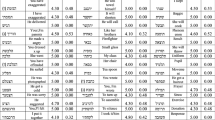Abstract
It is often discussed whether dyslexics show a deviant pattern of reading and spelling development when compared to typically developing students, or whether they follow the same pattern as other students, only at markedly slower rate. The present cross-sectional study investigated phonological encoding skills in dyslexic Danish students. We compared dyslexic and non-dyslexic students from grades 3, 5, 7, and 9 and examined whether effects of item length were stronger in the dyslexic groups. Mixed between-within subjects analyses of variance revealed significant interactions between dyslexia status and item length as the dyslexics at all grade levels were more affected by item length than their non-dyslexic peers. A marked developmental delay was apparent as the dyslexic group from grade 9 performed on approximately the same level as the non-dyslexic group from grade 3. Although the overall difference between these two groups was not significant, a significant interaction between dyslexia status and item length remained because the grade 9 dyslexics were more affected by item length than the younger non-dyslexic students. This difference in error profiles suggests a difference in the developmental patterns of dyslexic vs. non-dyslexic students.



Similar content being viewed by others
References
Bourassa, D., & Treiman, R. (2008). Morphological constancy in spelling: a comparison of children with dyslexia and typically developing children. Dyslexia, 14, 155–169.
Bruck, M., & Treiman, R. (1990). Phonological awareness and spelling in normal children and dyslexics: the case of initial consonant clusters. Journal of Experimental Child Psychology, 50, 156–178.
Cassar, M., Treiman, R., Moats, L., Pollo, T., & Kessler, B. (2005). How do the spellings of children with dyslexia compare with those of nondyslexic children? Reading and Writing, 18, 27–49.
Diamanti, V., Goulandris, N., Stuart, M., & Campbell, R. (2014). Spelling of derivational and inflectional suffixes by Greek-speaking children with and without dyslexia. Reading and Writing: An Interdisciplinary Journal, 27(2), 337–358.
Elbro, C. (2006). Literacy acquisition in Danish: a deep orthography in cross-linguistic light. In R. M. Joshi & P. G. Aaron (Eds.), Handbook of orthography and literacy (pp. 31–45). Mahwah: Lawrence Erlbaum.
Friend, A., & Olson, R. K. (2008). Phonological spelling and reading deficits in children with spelling disabilities. Scientific Studies of Reading, 12, 90–105.
Gagl, B., Hawelka, S., & Wimmer, H. (2015). On sources of the word length effect in young readers. Scientific Studies of Reading, 19(4), 1–18.
Landerl, K., & Wimmer, H. (2008). Development of word reading fluency and spelling in a consistent orthography: An 8-year follow-up. Journal of Educational Psychology, 100, 150–161. https://doi.org/10.1037/0022-0663.100.1.150.
Lyon, G. R., Shaywitz, S. E., & Shaywitz, B. A. (2003) A definition of dyslexia. Annals of Dyslexia, 53.
Martens, V., & de Jong, P. F. (2006). The effect of word length on lexical decision in dyslexic and normal reading children. Brain and Language, 98, 140–149.
Moats, L. C. (1983). A comparison of the spelling errors of older dyslexic and second grade normal children. Annals of Dyslexia, 22, 121–140.
Moats, L. C. (1993). Spelling error interpretation: beyond the phonetic/dysphonetic dichotomy. Annals of Dyslexia, 43, 174–185.
Moats, L. C. (1995). Spelling: development, disability, and instruction. Baltimore: York Press.
Nelson, H. E. (1980). Analysis of spelling errors in normal and dyslexic children. In U. Frith (Ed.), Cognitive processes in spelling (pp. 475–493). London: Academic Press.
Nielsen, A.-M. V., & Juul, H. (2016). Predictors of early versus later spelling development in Danish. Reading and Writing: An Interdisciplinary Journal, 29, 245–266. https://doi.org/10.1007/s11145-015-9591-y.
Ohala, J. J. (1981). Speech timing as a tool in phonology. Phonetica, 38, 204–212.
Olson, R. K., Kliegl, R., Davidson, B., & Foltz, G. (1985). Individual and developmental differences in reading disability. In G. Mackinnon & T. Waller (Eds.), Reading research: advances in theory and practice (pp. 2–57). Orlando: Academic Press, Inc..
Ordblindetestkonsortiet [‘The Dyslexia Test Consortium’] (2014a). Teknisk Rapport om Ordblindetesten ['Technical Report on the Dyslexia Test']. Center for Læseforskning, Københavns Universitet, & Skoleforskningsprogrammet, IUP, Aarhus Universitet. https://ordblindetest.nu/vejleder/pdf/TekniskRapportOrdblindetesten.pdf.
Ordblindetestkonsortiet [‘The Dyslexia Test Consortium’] (2014b). Vejledning til Ordblindetesten [‘Guidelines for the Dyslexia Test’]. Center for Læseforskning, Københavns Universitet, & Skoleforskningsprogrammet, IUP, Aarhus Universitet. https://ordblindetest.nu/vejleder/pdf/VejledningOrdblindetesten.pdf.
Petersen, D. K, Juul, H., Elbro, C., Poulsen, M., Møller, H. L., & Arnbak, E. (2015). Dyslexia from grade 3 through university: validity of a single wide-range test. Paper presented at the SSSR’s annual meeting in Kona, Hawaii, July.
Protopapas, A., Aikaterini, F., Styliani, D., Skaloumbakas, C., & Angeliki, M. (2013). What do spelling errors tell us? Classifiation and analysis of errors made by Greek schoolchildren with and without dyslexia. Reading and Writing, 26, 615–646.
Seymour, P. H. K., Aro, M., & Erskine, J. M. (2003). Foundation literacy acquisition in European orthographies. British Journal of Psychology, 94, 143–174. https://doi.org/10.1348/000712603321661859.
Shaywitz, S. E., & Shaywitz, B. A. (2005). Dyslexia (specific reading disability). Biological Psychiatry, 57(11), 1301–1309.
Vellutino, F. R., Fletcher, J. M., Snowling, M. J., & Scanlon, D. M. (2004). Specific reading disability (dyslexia): what have we learned in the past four decades. Journal of Child Psychology and Psychiatry, 45(1), 2–40.
Wagner, R. K., & Torgesen, J. K. (1987). The nature of phonological processing and its casual role in the acquisition of reading skills. Psychological Bulletin, 101, 192–212.
Worthy, M. J., & Invernizzi, M. (1990). Spelling errors of normal and disabled students on achievement levels one through four: instructional implications. Annals of Dyslexia, 40, 138–151.
Author information
Authors and Affiliations
Corresponding author
Appendix
Appendix
Rights and permissions
About this article
Cite this article
Juul, H., Petersen, D.K. Length effects in pseudo-word spelling: stronger in dyslexic than in non-dyslexic students. Ann. of Dyslexia 67, 369–382 (2017). https://doi.org/10.1007/s11881-017-0149-3
Received:
Accepted:
Published:
Issue Date:
DOI: https://doi.org/10.1007/s11881-017-0149-3




